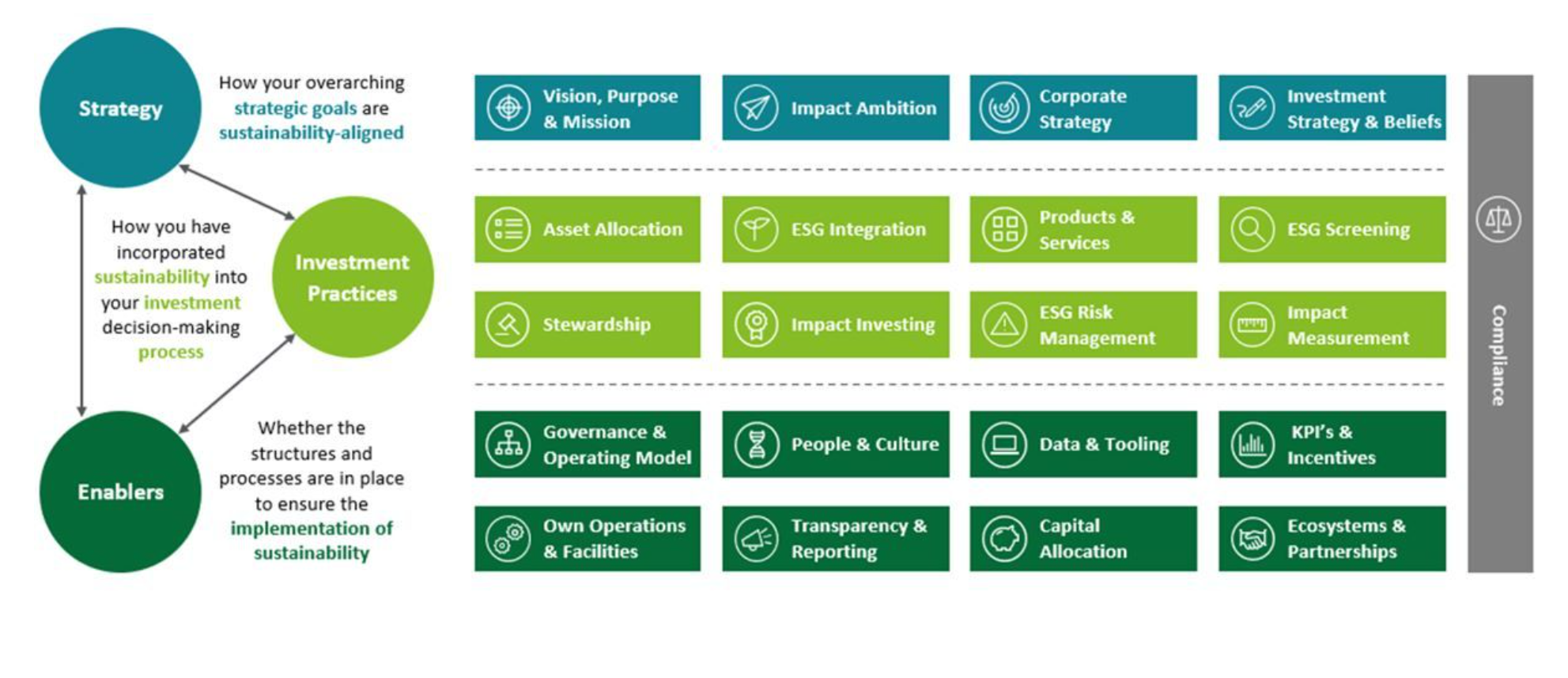Today’s investors have a massive opportunity if they can win in the continuously growing market of sustainable investments. For the most advanced sustainable investors, there is a unique chance to attract and retain talent, generate superior risk adjusted returns, achieve higher net promoter scores from clients and equip oneself for a wave of upcoming regulation.
Recognizing this, CEOs and decisions makers throughout the financial services industry are facing tough decisions about where to play and how to win in sustainability. At Deloitte, our clients and partners are asking us the same question: “How can I measure and improve my maturity as a sustainable investor?”
Truly sustainable investors have successfully integrated sustainability into every aspect of their organization. Advanced investors articulate the tangible impact they intend to have, guide that intention with a coherent strategy, and execute on it throughout their investment process with the support of operational requirements like a solid governance structure, data, and capital allocation.
At Deloitte, we have developed the Sustainable Investor Framework consisting of 20 ‘levers’ across the pillars of Strategy, Investment Practices, and Enablers. By improving performance on each lever, and reinforcement between levers, organizations can advance their performance in sustainable investing.
Image 1: The Deloitte Sustainable Investor Framework, consisting of 20 levers across the three pillars: Strategy, Investment Practices and Enablers
Strategy
Leaders have embedded sustainability into their overarching strategic goals.
Leading investors have embedded sustainability into their overarching strategic goals. They have a clear vision to set the direction for the type of organization they intend to be, articulate the intended impact of that organization, and develop both corporate and investment strategies around delivering this impact.
This sets the guidelines to design and manage Investment Practices and Enablers in a reinforcing manner, and can increase trust and legitimacy among clients, partners and other stakeholders.
Candriam, a global investment manager, provides an example of an organization that has at least begun to integrate sustainability into their mission statement.
Candriam’s mission sets the direction for the type of business it intends to be, why it exists and what greater cause it contributes to. The intentions set in the mission statement provide managers with clear principles to guide decision making. One can see how Candriam’s creation of an in-house research team dedicated to ESG factors logically aligns with the intentions of the company mission. This is also reflected in Candriam’s approach towards Stewardship, voting against company resolutions that do not support their view of sustainable development and engaging in ‘Direct Dialogue Campaigns’ with companies about climate change.
Investment practices
Leaders have found ways to incorporate their sustainability-aligned strategic goals into their investment process.
Mature sustainable investors must also find ways to incorporate their sustainability-aligned strategic goals into their investment decision-making process. They go beyond broad, sector defined ESG ratings to create their own, tailored approach to ESG integration, risk management and other investment processes.
As a result, these investors are able to actively quantify the value and risk of different ESG factors into their valuations, which can not only help protect the organization from downside risk, but also help generate sustainable, long-term returns1.
A great example of this can be found in Robeco. The company boasts a large Sustainability Investing department to research, evaluate and guide the company through its investment process.
Robeco also has an SDG framework which evaluates the extent to which a company contributes to the SDGs and whether it qualifies for the integration into sustainable investment portfolios. Through a combination of its numerous ESG integration methods, Robeco is able to report over 95% AuM in ESG-integrated assets.
Enablers
Leaders make use of high quality data and tooling, allocate capital efficiently, and define governance and operating models which are fit for purpose.
Finally, mature sustainable investors excel at the each of the individual enablers which serve as the bedrock of their strategy and investment practices. They make use of high quality data and tooling, allocate capital efficiently to fund their sustainable agenda, and define governance and operating models which are fit for purpose.
Doing so allows organizations to execute on all of the levers within strategy and investment practices defined previously, as they have the resources and incentives necessary to make the right decisions.
Global asset manager Schroders has created proprietary tools to support its sustainability decision making at scale. Each of its analysts and fund managers has access to CONTEXTTM, a tool which provides a forward looking view on how sustainable the business models of thousands of companies are, available through the firm’s global research platform.
With the Sustainable Investor Framework, decision makers can measure their performance, and make decisions about where to play and how to win in the investment management space.
As we see, being a mature sustainable investor requires much more than complying with upcoming regulation and screening out bad actors from the investible universe. The best out there have taken the opportunity to create an integrated vision which connects Strategy, Investment Practices and Enablers.
With the Sustainable Investor Framework, CEOs and other decision makers can go step by step in comparing their performance against best practices, and make decisions about where to play and how to win in their market. Deloitte’s experience in sustainable investment, depth of research and network of experts within the financial services community can support you on your journey to becoming a more mature sustainable investor.
Ivan Kukhnin, partner Deloitte Nederland








